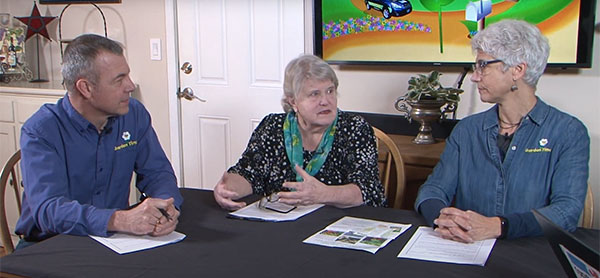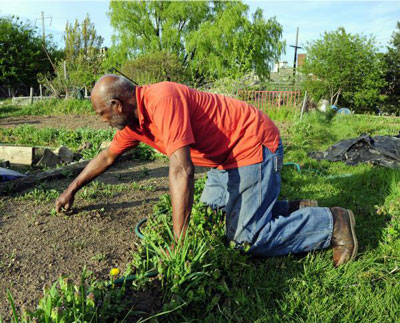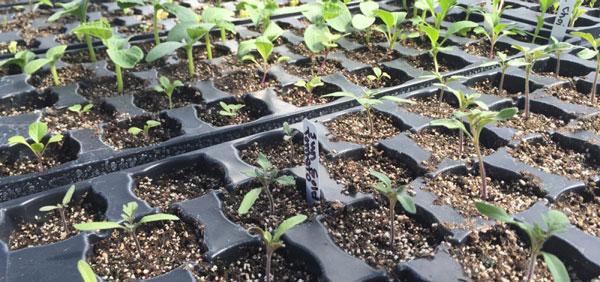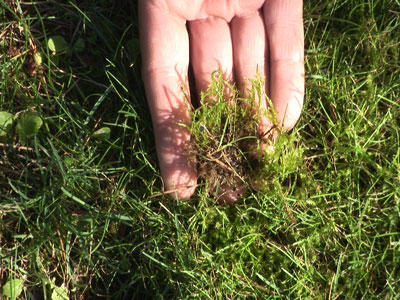|
Season 2 • Episode 4 - February 28, 2023

The late winter is always frustrating for the gardener.
The weather is cold, wet, and sometimes snowy. Yet, the
sun will often peek through the clouds and give us a
little time to get out in the garden do a few of those
late winter chores. But what should we be doing in the
winter garden as we prepare for spring? To get some tips
we welcomed Jan McNeilan, retired Oregon State
University Extension agent, back to the podcast. She
brought her ‘book of knowledge’ with her. Now we know
that this is not an actual book, but notes from her and
her husband Ray’s years of experience in the university
extension service. A lot of these tips we covered when
we had the TV show, but now we have time to go a little
further in depth on some of the topics.
 The
first thing we talked about was pruning. This is a topic
that we discussed in the past because the winter is one
of the best times to cut back your shrubs and trees. We
are talking about the late summer shrubs in particular.
If you cut back your spring blooming perennials at this
point you will be cutting off the new buds and blooms.
The spring flowering plants set their new blooms in the
mid-to-late summer and the best time to prune them is
right after they bloom in the spring and early summer.
Now there are a bunch of spring bloomers that you can
prune in the late winter and those include most of your
fruit trees and shrubs. Apples, pears, peaches, grapes,
fruiting plums, figs and apricots can all be pruned at
this time to shape and to promote better production. The
key with these fruiting plants is knowing which part to
prune. For example, if you cut off the fruiting spurs on
your cherries and apples, it can reduce your yield.
Check out the OSU Extension website for tips and
diagrams on what to cut off. Roses and wisteria are a
couple of flowering shrubs that you can prune in the
late winter. In fact we talked about how Presidents' Day
is a good reminder to do your rose pruning. You can do
your major rose cutting right now and take things down
pretty far. Blueberries are also a plant that you can
take back right now. For the blueberries you will want
to remove about 1/3 of the oldest wood every year (it
will have a bark, whereas new canes are green and
smooth). Blueberries fruit on the newer wood better than
the older canes. If you miss your pruning on President’s
Day for your roses, don’t worry, you can cut them back
later this winter or even early spring. A delay in
pruning will just mean a delay in their blooming. In
fact, if you don’t prune they will still send up
flowers, they will just be on a taller plant. The
first thing we talked about was pruning. This is a topic
that we discussed in the past because the winter is one
of the best times to cut back your shrubs and trees. We
are talking about the late summer shrubs in particular.
If you cut back your spring blooming perennials at this
point you will be cutting off the new buds and blooms.
The spring flowering plants set their new blooms in the
mid-to-late summer and the best time to prune them is
right after they bloom in the spring and early summer.
Now there are a bunch of spring bloomers that you can
prune in the late winter and those include most of your
fruit trees and shrubs. Apples, pears, peaches, grapes,
fruiting plums, figs and apricots can all be pruned at
this time to shape and to promote better production. The
key with these fruiting plants is knowing which part to
prune. For example, if you cut off the fruiting spurs on
your cherries and apples, it can reduce your yield.
Check out the OSU Extension website for tips and
diagrams on what to cut off. Roses and wisteria are a
couple of flowering shrubs that you can prune in the
late winter. In fact we talked about how Presidents' Day
is a good reminder to do your rose pruning. You can do
your major rose cutting right now and take things down
pretty far. Blueberries are also a plant that you can
take back right now. For the blueberries you will want
to remove about 1/3 of the oldest wood every year (it
will have a bark, whereas new canes are green and
smooth). Blueberries fruit on the newer wood better than
the older canes. If you miss your pruning on President’s
Day for your roses, don’t worry, you can cut them back
later this winter or even early spring. A delay in
pruning will just mean a delay in their blooming. In
fact, if you don’t prune they will still send up
flowers, they will just be on a taller plant.
Now is a good time to plant some of your woody
ornamental plants too. Arborvitea, fir and pine trees,
roses, rhododendrons, lilacs and roses can be planted if
you can work the soil. Some of the taller plants may
need to be staked for one season or at least through the
spring to avoid tipping over in the stronger gusts.
Remember to remove the stakes after the first year to
prevent girdling your new plants. The key here is like
any other time of year: Prepare your soil well and make
sure that your plant is well-watered once you plant it.
You will see lots of bare root trees and roses in your
garden centers right now. Since they are winter dormant
you can plant them directly in the ground right now. In
fact, planting them now will give them time to acclimate
and get a head start on root development. Plus the
selection of varieties are the best right now, too. Late
winter is also a great time to dig and divide some of
your other perennials like hostas and epimediums.
 Our
next topic asked the question, "Is it too early to clean
up your garden?" There is a difference between cleaning
up, and CLEANING UP. Cutting off the dead and diseased
branches and flower stalks should be OK, but you may
want to hold off on cleaning up your mulch and soil
covering. This mulch is still protecting your plants and
could be protecting those beneficial bugs that are
overwintering in your beds. You don’t want to wait too
long (a good time would be late March to mid-April)
because if you leave some of the leaf mulch covering
your new bulbs it may cause them to stretch for sun and
get too long and leggy. This brought us around to bulbs
in general. This time of year you will start to see some
of your early spring bulbs appearing and this gets
people concerned because they think that the plant will
suffer in the cold and snow. However the bulbs are
designed for this. They have very thick early leaves and
the flower is still protected deep inside the plant.
They will be fine. Our
next topic asked the question, "Is it too early to clean
up your garden?" There is a difference between cleaning
up, and CLEANING UP. Cutting off the dead and diseased
branches and flower stalks should be OK, but you may
want to hold off on cleaning up your mulch and soil
covering. This mulch is still protecting your plants and
could be protecting those beneficial bugs that are
overwintering in your beds. You don’t want to wait too
long (a good time would be late March to mid-April)
because if you leave some of the leaf mulch covering
your new bulbs it may cause them to stretch for sun and
get too long and leggy. This brought us around to bulbs
in general. This time of year you will start to see some
of your early spring bulbs appearing and this gets
people concerned because they think that the plant will
suffer in the cold and snow. However the bulbs are
designed for this. They have very thick early leaves and
the flower is still protected deep inside the plant.
They will be fine.
Another question we hear regards early season weeding
and baiting for pests. The feeling is that weeding is
fine. In fact, it may cut down the weed seeds that will
get spread in the early spring. Staying on top of the
weeds will help control them later in the spring and
reduce the need for sprays and other controls. Producer
Jeff then asked about preemergent treatments. These
treat the soil to prevent weed seeds from sprouting, but
it can also inhibit the growth of your other garden
plants and seeds. Always be careful about applying any
chemical (organic or synthetic) to your garden and read
the directions on the label. Baiting for slugs can also
be done now, but be aware that they are not as active in
the cold as they are later in the spring. However,
getting them early is a good thing. Each slug can lay
over 100 eggs and so if you get on them early you can
reduce the number you see later in your garden. You
should look for slugs, snails or their damage to
determine if you need to bait now.

We then got into
seed-starting. A lot of gardeners want to start their
seeds now to get a jump on the season. For some that
means growing them inside. For others it could mean that
they are planting directly outside for those cold
weather crops like peas, lettuces, carrots, broccoli and
kale. For those crops and other warm season crops, Jan
will write the temperature for germination on the seed
packet itself. In fact, the seed packet for most seeds
is a source for an abundance of information about
growing, caring and harvesting for those plants. Some
people will even try to plant warmer-weather seeds and
even plants outside when the temps are not really warm
enough for them to thrive. A good example are tomatoes.
You can find the plants in your garden center early in
the season. But if you plant them outside without
protection they will wither or die. Then you must make
the trek back to get more of them later in the season.
We know that last year it was so cold and wet that many
people didn’t get their warm weather crops like tomatoes
and basil in the ground until June, and they still
performed well at harvest time. If you do start seeds
you will want to have a warm and sunny spot in your
home. Start with a container (some say egg containers
may not work, but give it a try) and fill it with a good
sterile planting soil. You can get seeds from your local
garden center or even use old seeds that you saved or
harvested from your garden last year. But how can you
tell if they are still good and will germinate? For
those really old seeds you can take 10 of them and put
them in a wet paper towel. If 3 germinate then you can
guess that 30 percent will germinate. The rule of thumb
for the old seed germination is as follows:
| 1
Year: Leeks, onions, parsnips and sweet
corn |
| 2
Years: Okra and parsley |
| 3
Years: Asparagus, beans, carrots and
peas |
| 4
Years: Beet, mustard, peppers, pumpkins
and tomatoes |
| 5
Years: Cabbage, celery, cucumbers,
eggplant, lettuce, melons, radishes,
rutabagas, spinach and squash |
Once in the soil,
keep them moist, but not soaking wet. You can use a heat
mat or grow lights to help them grow, but it isn’t
always necessary. Wait until they have roots coming out
the bottom of your seed tray and they have 2-3 sets of
leaves before you even think about putting them out, and
then watch for pests and frost. Watch your soil
temperature, too. When it hits 50 degrees, it is a good
time to get them in the ground. If it is colder than
that, they may just sit there until the soil gets warm,
anyway.
 Lawn
and moss were also on Jan’s list. It may be too cold for
your lawn to grow but you can mow it to clean up debris
like Ryan recently did. Planting grass seed to fill in
dead patches is still too early to do. Jan told us that
the dates between April 15 to October 15 are the best
for seed growth. If you have moss, applying a product
also may be a waste of time since a lot of them may work
well only when the ground temperatures are a little
warmer. The details will be on the moss control product. Lawn
and moss were also on Jan’s list. It may be too cold for
your lawn to grow but you can mow it to clean up debris
like Ryan recently did. Planting grass seed to fill in
dead patches is still too early to do. Jan told us that
the dates between April 15 to October 15 are the best
for seed growth. If you have moss, applying a product
also may be a waste of time since a lot of them may work
well only when the ground temperatures are a little
warmer. The details will be on the moss control product.
Right now, cleaning and sharpening your garden tools is
also a good thing. Getting them ready will make those
late winter and early spring chores go much more
smoothly. Moles and gophers may also start getting more
active. Our thought is that if they are not causing too
many problems, leave them alone. They do benefit the
soil by digging their tunnels. If you need a reminder,
moles eat worms and grubs, gophers eat roots, bulbs and
vegetation. Ryan suggested cleaning up the old chemicals
in your garden shed. These outdated garden products are
considered hazardous waste and should be dealt with in a
safe manner. In the Portland, Oregon metro area
you can go to this link for details on recycling
these products. If you are not in that area, check with
your local waste collection provider or your local
garden center.
We ended by talking about ways to get everyone involved
in these early season chores, including children. Having
the kids help with vegetable starting will help them to
become lifelong gardeners. Plus, it can be a lot of fun,
too! One way to help you get excited for the coming
spring and summer is to bring in early season flowers
and keep them in your house. Hellebores floating in a
bowl will bring that wonderful spring color inside. Some
people even cut the early budded branches of quince,
forsythia and flowering plum and bring inside to watch
them bloom in a vase. Outside fragrance will also add to
the excitement!
Late winter is the time to plan and plant. You can get a
lot of things done and set the table for a successful
gardening season ahead. For more information you can
check out the Oregon State University Extension website.

PODCASTS
2022
• Return to Current Year Podcast List
 |